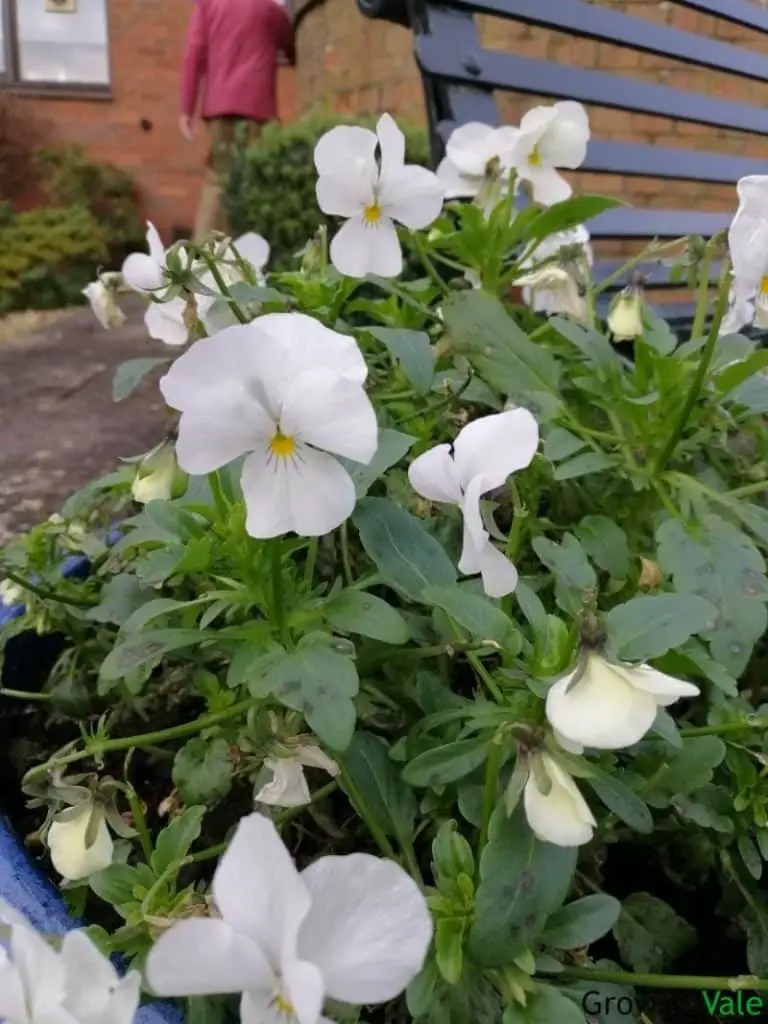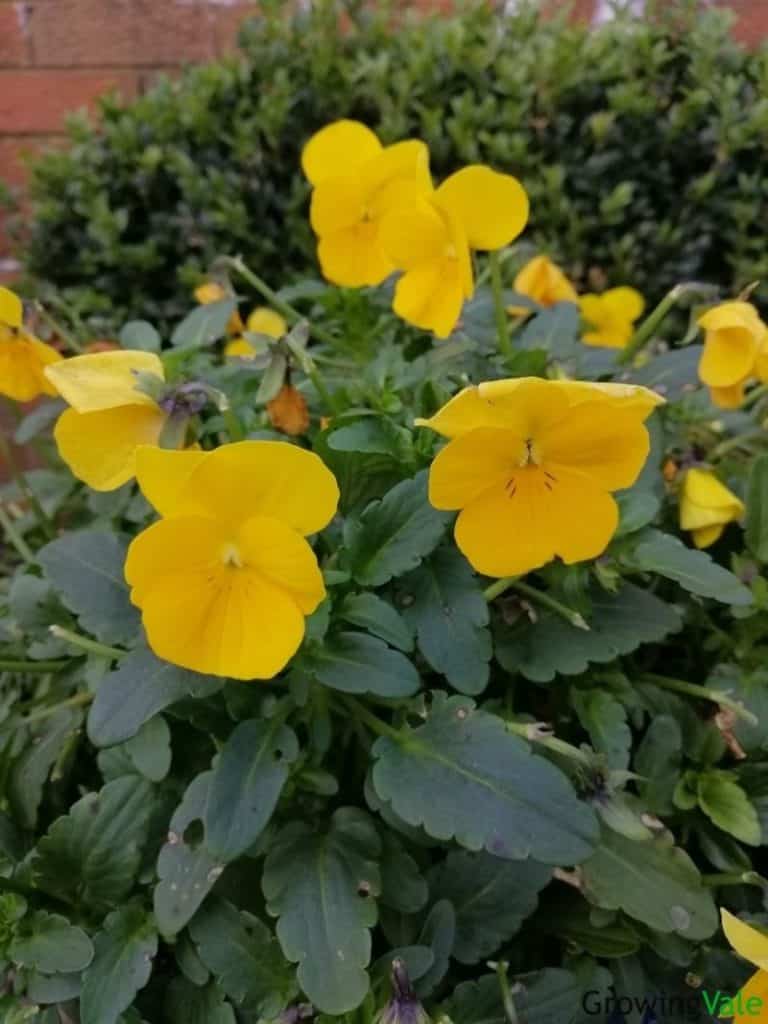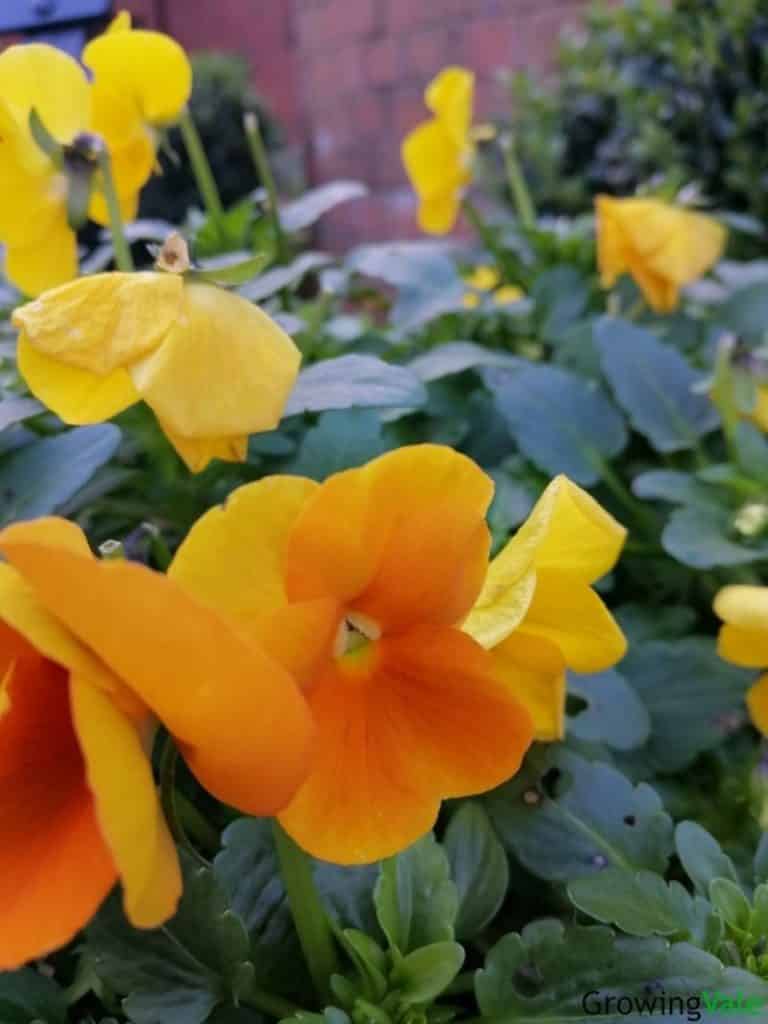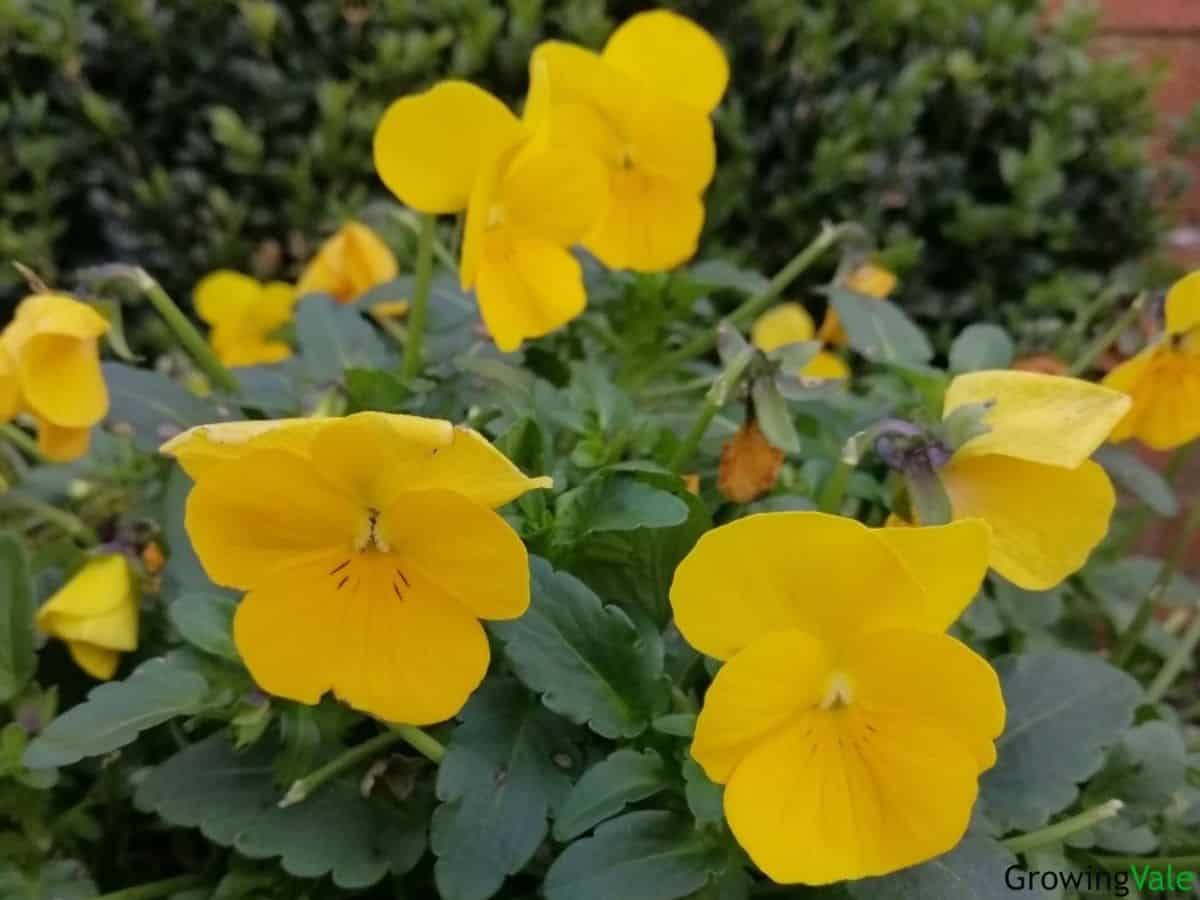Pansies are one of the most popular bedding plants amongst gardeners! These cool-weather favorites are particularly useful for adding color to gardens during winter!
Although the common name “pansy” is sometimes used to refer to several cultivated flowers within the Viola genus such as Viola tricolor, the plant most people associate with the name pansy is Viola x wittrockiana.
V. x wittrockiana has garden origins and is a hybrid of several viola species such as V. tricolor, V. lutea, V. altaica, and V. cornuta. Compared to other violas, pansies are large-flowered and tend to have markings or blotches that resemble a face.
In cooler climates, they will bloom into the summer, and in hotter climates, they can be replanted after the height of summer for a winter bloom! They are short-lived perennial plants, but in most climates are grown as annuals.
History
Pansies have been highly cultivated for hundreds of years, with their signature markings first discovered in the 1830s as a mutation. During this time they were becoming more and more popular throughout mainland Europe and the U.K. as garden ornamentals. Since then, cultivation has come a long way, with trailing pansies now available, which are perfect for hanging baskets and window boxes!
Their genus name Viola is derived from the Latin name for sweet-scented flowers, however, the common name pansy comes from the French word “pensée” which means thought or remembrance. In the language of flowers, pansies represent the thoughts of lovers and were a key ingredient in many 19th-century love potions.
Pansy blossoms open faces and overlapping petals. They have 4 upward-facing petals and a single downward-facing petal. Many are sweet-scented, and their large flowers come in many pretty colors such as white, pink, red, orange, yellow, blue, black, and purple. Bi-color and multi-colored varieties also exist. They make wonderful bedding plants and are great for container planting too!
Plant Facts
| Scientific name | Viola x wittrockiana |
| Common names | Pansy, Lady’s Delight, Garden Pansy |
| Genus | Viola |
| Family | Violaceae |
| Height | 0 ft. 6 in. – 1 ft. 0 in. |
| Width | 0 ft. 8 in. – 1 ft. 0 in. |
| USDA Plant Hardiness Zone | 6 – 10 |
| Origin | Garden origin |
| Flower colors | White, Pink, Red, Yellow, Orange, Purple, Blue, Black, Bi-color, Multicolor |
| Blooming season | Spring, Fall, and Winter |
| Plant/Flower special features | Fragrant showy flowers, useful for winter gardens |
How to Plant and Grow Pansies
Fall planted pansies are perfect for adding fall, winter, and spring color to the garden! They are usually grown as annuals by most gardeners as their blooms wither in the heat of the summer, and plants can become a little leggy. Some pansy varieties are more cold-hardy than others and can tolerate some light snow cover. So, for the best winter display, a little research may help.
Pansies can be started from seeds, but for those who don’t have the time or space, they can be easily purchased in nurseries, online stores, and garden centers, ready for transplantation.

Growing Pansy Flowers in Beds
Plant pansies either in early spring once the ground has become workable, or in the fall. First, prepare the site by removing any weeds and turning up the soil. Discard any large stones or hard clumps of dirt. Amend the soil if needed with compost and well-rotted manure to make it humus-rich.
Dig a hole large enough and wide enough to comfortably fit the root ball of the pansy plant. If opting for a slow-release granular fertilizer, now is the time to apply it into the planting hole following package instructions. Gently remove the plant from its container and put it into the hole at the same depth it was previously growing, fill in the soil, and gently firm it down to remove any air pockets.
Water well to settle in, making sure to avoid wetting the pansy flowers and foliage. Plant smaller flowered varieties 6-8 inches apart, and larger flowered varieties 10-12 inches apart.
Growing Pansy Flowers in Containers
Pansies make fantastic container plants that will brighten up any patio garden, courtyards, or balcony! Plant them alongside other brightly colored pansies, or for a pretty spring display, pair them with spring bulbs such as bluebells and daffodils. For a striking winter container display, plant pansies with heather, primroses, and cyclamens!
First, choose a suitable container. Plastic or glazed ceramic pots are ideal for fall plantings. Unglazed pots like clay or concrete will wick away moisture causing the soil to dry out too quickly and may crack with the cold temperatures. Clay or concrete containers are fine for spring plantings. Ensure the pot has sufficient drainage otherwise the soils will become cold and water-logged, causing root rot.
Fill the container with a well-draining potting mix and follow the above instructions for planting. For container-grown pansies, use a liquid fertilizer instead of granular every 1-4 weeks following the package instructions. Leave a 1-inch gap between the top of the soil and the container to leave room for water to soak in.

How to Propagate Pansies
Pansies can be propagated from seeds. Either start them indoors 10-12 weeks before the last spring frost for a spring bloom, or a fall to winter bloom, sow them outdoors from May to July.
Sowing Seeds Indoors
Fill a container or tray with seeding compost. Sow the seeds on top of the soil and cover them with a light layer of compost. Moisten the soil slightly before covering the container and placing it in a refrigerator for 2 weeks, as pansies need cold stratification to induce germination.
After the 2 weeks have passed, move the tray into a dark, heated area with temperatures between 65 and 70°F. Expect the seeds to germinate in 14 to 21 days. Once they have germinated, place the seedlings under grow lights or next to a sunny window. When the seeds have developed their first pair of true leaves, thin them out to prevent overcrowding.
Harden off the seedlings before planting them out in spring.
Sowing Seeds Outdoors
Pansies can be sown directly outdoors from May to July. A common problem is the small seeds being washed away by the rain, so sowing them in outdoor containers may have more successful results. Make sure to choose a dry day for sowing.
To sow pansies outdoors, first prepare the area by removing any weeds and raking the top of the soil. Sow the seeds on top and cover them with a light layer of soil. Water them using a watering can fitted with a rose sprinkler head to avoid dislodging the soil and seeds.
Wait for the seedlings to germinate and thin them out once they are strong enough. Protect the seedlings with horticultural fleece during frosty weather.

Pansy Care and Maintenance
Here are some useful tips for growing pansies in the garden:
Soil
When planting pansies, choose soil that is consistently moist, humusy, and well-drained. Pansies also prefer slightly acidic soil.
Water
Water pansies regularly. They should receive at least 1-inch of water per week (either from rain or from watering). However, bear in mind that those grown in containers may need watering more often as the soils can dry out quicker. While pansy plants like consistent moisture, take care not to overwater them as they are susceptible to root rot.
Pansies growing in winter gardens should be given a good watering before a hard freeze to ensure their roots get enough water before they become frozen.
Fertilizer
Pansies can be fertilized to help them to perform at their best. Slow-release granular fertilizer should be added into the soil during planting, and again mid-way through the growing season. A 5-10-10 fertilizer is best, as too much nitrogen can make them prone to root rot and cause stunted growth, otherwise, apply a well-balanced fertilizer.
Alternatively, use a water-soluble fertilizer every 1-4 weeks, following the package instructions.
Mulching pansies with organic material is a good additional step that will help to control weeds and help the soil to conserve moisture.
Sunlight
Pansies may be grown either in full sun to partial shade conditions. In warmer climates, some morning sun and light afternoon shade are very welcome and can improve flowering.
Temperature and Humidity
Most pansies are cool weather plants and dislike the heat of summer, but there are some heat-tolerant varieties available.
These plants grow best in rich soil with temperatures between 45°F and 65°F. They are tolerant of frost and can bloom as long as air temperatures are above freezing (32°F).
Pest and diseases
Pansies are susceptible to aphids, mealybugs, spider mites, slugs, and parasitic nematodes.
Some common problems they may encounter are powdery mildew, black root rot, and fungal leaf spots. To minimize these, plant pansies apart to allow for airflow, take care not to overwater them, and water the base of the plant, taking care not to get water on their leaves or flowers. Never water pansies in the late afternoon or evening as this can encourage disease.
Pruning
Deadhead pansies to prolong a longer blooming season and encourage more blooms. Their stems can also be cut back by 3-4 inches to rejuvenate them and prevent leggy growth.
Toxicity
Pansies are mildly toxic to dogs if consumed in large quantities or over long periods. They won’t cause serious illness but can cause vomiting and diarrhea.
Uses of Pansy Flower
Pansies are extremely popular garden ornamentals used for mass coloring, edging on pathways, container planting, and window boxes. They are a top choice for adding some color to fall gardens.
Their flowers are edible, often used in salads or candied for cake decoration, and are said to have a slight minty taste. They can be dried and used in potpourri, or even as a natural dye.
Common Varieties and Cultivars
There are over 250 beautiful types of pansies to choose from! Here are some of the most popular varieties:
- Cool Wave White – Part of the Cool Wave series, this fantastic pansy flower has a trailing habit, making it a top choice for containers! It grows between 6 and 8 inches tall and will spread/trail as wide as 30 inches. It has pure white petals, with a golden yellow throat decorated with brown whiskers.
- Jolly Joker – This compact pansy plant has striking flowers with fiery orange petals and velvet purple wings. It grows to 8 inches high and has large 2.5-3-inch blooms!
- Matrix Orange – Matrix Orange is a member of the Matrix Series, known for its cold tolerance. This cultivar grows as large as 8 inches and produces many flowers! Its flowers are bright orange and are sure to brighten up any outdoor space!
- Matrix Morpheus – This easy-to-grow pansy cultivar has a height and spread of 9 inches. Its flowers have deep purple wings, and yellow petals that fade white and purple at their edges. Its yellow petals are decorated with contrasting purple veins.
- Silver Wings – Silver Wings have deep purple petals kissed with white edges, a golden yellow throat, and white wings. It can grow as tall as 9 inches and is a wonderful pansy for cottage-style garden borders.
Conclusion
Pansies are a fantastic choice of flowers for either winter or spring beds! They belong to the Viola genus and are often confused with other flowering violas. However, V. x wittrockiana is what most gardeners are referring to when they are talking about pansies.
They are hybridized crosses of several species of violas such as V. tricolor, V. lutea, V. altaica, and V. cornuta. Pansies have been cultivated for hundreds of years and first became popular in Europe in the 1800s! Nowadays, there are over 250 cultivars with several trailing varieties available that are fantastic for hanging baskets.
These viola plants have open-faced flowers with 4 upward-facing petals and 1 downward-facing petal. They can be sweetly fragranced and are often adorned with distinct markings and whiskers. Pansies come in a variety of colors and color combinations such as white, yellow, orange, pink, red, blue, purple, and even black!
They do not like the heat of summer and grow best in cooler climates. They can tolerate frost, with some varieties coping better with the colder temperatures than others. Pansies are a firm favorite for winter displays and look sensational planted alongside other winter bloomers such as heather, cyclamens, and primroses.
See more: Pansy flower meaning
*References
Reference list:
Clemson Cooperative Extension, Pansies and Johnny Jump Ups https://hgic.clemson.edu/factsheet/pansies-and-johnny-jump-ups/
Cornell University, Pansy
http://www.gardening.cornell.edu/homegardening/scenede13.html
NC State Extension, Viola × wittrockiana
https://plants.ces.ncsu.edu/plants/viola-x-wittrockiana/
University Of Vermont, Growing Pansies
https://pss.uvm.edu/ppp/articles/pansies.html
”Close”

